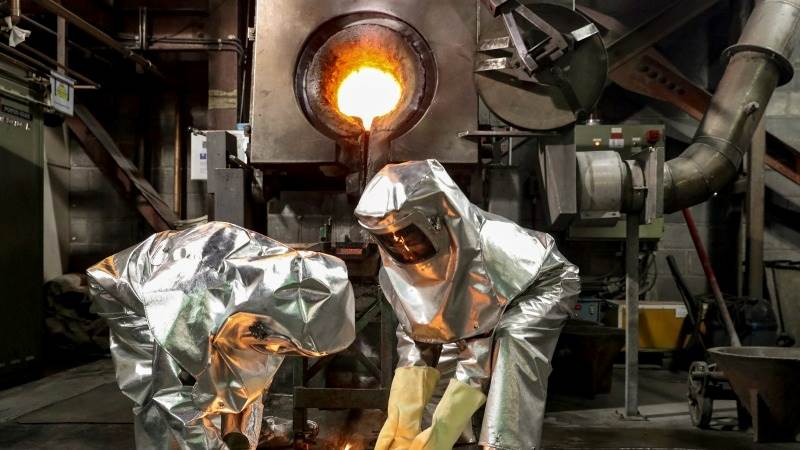
The melting point of precious metals is a topic that often generates inquiries. The melting point may affect the final product. Knowing the melting point of precious metals is essential if you want to melt them or subject them to very high temperatures. Examine our concise explanations, and chart for more common metals featured in our comprehensive chart for their melting points.
| Metal | Melting Point Celsius | Melting Point Fahrenheit |
| Aluminum | 659 | 1218 |
| Brass (85 Cu 15 Zn) | 900-940 | 1652-1724 |
| Bronze (90 Cu 10 Sn) | 850-1000 | 1562-832 |
| Cast Iron | 1260 | 2300 |
| Copper | 1083 | 1981 |
| Gold (24k) | 1063 | 1946 |
| Iron | 1530 | 2786 |
| Lead | 327 | 621 |
| Nickel | 1452 | 2646 |
| Palladium | 1555 | 2831 |
| Platinum | 1770 | 3220 |
| Red Brass | 990 – 1025 | 1810 – 1880 |
| Silver (pure) | 961 | 1762 |
| Silver (sterling) | 893 | 1640 |
| Stainless Steel | 1363 | 2550 |
| Steel-High Carbon | 1353 | 2500 |
| Medium Carbon | 1427 | 2600 |
| Low Carbon | 1464 | 2700 |
| Tin | 232 | 450 |
| Titanium | 1795 | 3263 |
| Yellow Brass | 905 – 932 | 1660 – 1710 |
| Zinc | 419 | 786 |
Metals have a well-deserved reputation for resilience. Excessive weight, repeated motion, violent impact, acidic or hot conditions, etc. Some metals may melt at high temperatures, always present in heaters, combustion engines, turbines, ignition nozzles, high-speed equipment, and exhaust systems. The melting point of a metal is one of the critical temperatures to consider when choosing to use it in a high-temperature application.
Why is the Melting Point of Metals Important?
The melting point of an alloy represents one of the most crucial temperatures it may attain throughout the fabrication operation or as a consequence of the application.
Item failure after a metal exceeds its melting point is one reason why the melting point is so crucial.
While metals may fail well before they melt, they can no longer perform their original function once they start to turn into a liquid.
For instance, the furnace will stop working if a crucial part starts to melt. The ports of a jet engine’s fuel nozzle may get clogged and make the machine inoperable if the nozzle itself melts.
Other forms of metal failure, like creep-induced breaks, may occur before the point of melting is reached. Thus, it’s necessary to undertake an advanced study on the impact of the different temperatures a metal will be exposed to.
Precious metals are at their most malleable when fluid, which explains why the melting point is crucial. Many industrial procedures need heating precious metals to their melting points.
Metals must be liquid for fusion, welding, and casting. Production procedures that involve metal melting need knowledge about the melting point of the metal so that suitable materials and equipment may be used.
A welding gun, for example, must be capable of coping with the high temperatures produced by an arc of electricity and hot metal. The melting point of casting equipment, such as dies, must be greater than that of the metal undercast.
Practical Considerations and Safety
Simple problems and safety procedures abound when dealing with precious metals and their melting points.
First, you must have machinery and tools capable of withstanding very high temperatures. Customized crucibles, tongs, and safety equipment are used to avoid burns and other accidents. Ventilation is also crucial to ensure that no hazardous gasses or fumes are breathed in throughout the melting process.
Safe practices should always be followed, including ensuring the work area is secure and free of combustible items. By taking these measures, you can make sure your melting goes smoothly and without incident. When dealing with precious metals, it’s also crucial to remember that they might vary widely in melting point.
The melting and boiling points of metals vary depending on the metal. Knowing those melting points is essential for successfully dealing with metals. The metal may be melted and cast with pinpoint accuracy, ensuring it achieves the ideal temperature for working with.
Rules for Maintaining Safety
Health should remain the number one concern, even above more mundane matters. Take care while working with hot equipment or materials, and always maintain a melting process.
In case of emergencies, fire extinguishers should also be close at hand. Accidents may be avoided by consistent upkeep and examination of equipment, including testing for electrical problems and replacing old components.
Individuals may ensure productive metalworking operations and a safe and secure workplace by learning about and implementing practical concerns and safety measures related to the melting points of precious metals.
To have a productive and risk-free workplace, keeping up with the exact melting points and qualities of the precious metals being used and regularly updating and enhancing safety standards is crucial.
Conclusion
The melting points of precious metals are crucial to unlocking their many uses. When we know the melting points of different metals, we may use their unique qualities in a wide range of applications. Melting points determine the properties of precious metals, such as their flexibility, conductivity, and high-temperature resistance. Consider the intriguing realm of melting points when you look at an item of gold jewelry or wonder at the efficiency of electrical equipment.

